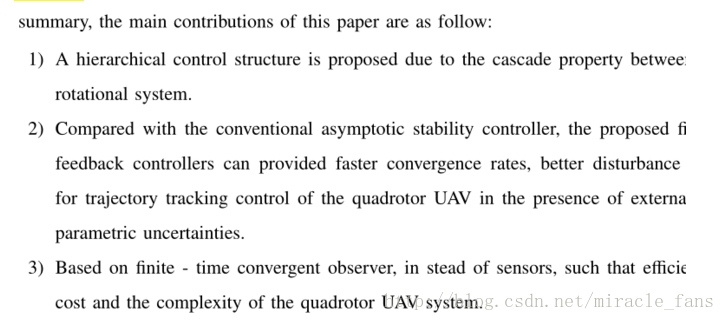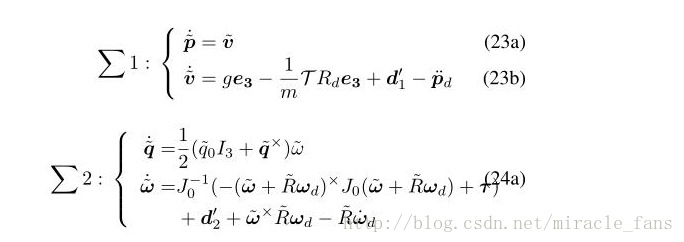LaTeX中三种列举的形式:itemize和enumerate还有description。
itemize(意为分条目):
\begin{itemize}
\item[*] a
\item[*] b
\end{itemize}
这样出来的形式为* a* bitem的方括号里的内容是为定制前面的符号,可以不要(连同括号),那么前面的符号就是默认的黑点,也可以换为其他的符号,如-,+,等
(2)enumerate(意为编号):
\begin{enumerate}[1)]
\item a
\item b
\end{enumerate}
这样出来的形式为:1) a2) b方括号里的内容是定制前面的编号的形式,可以不加,默认就是简单的数字,也可以换成[step 1],[(i)]等,LaTeX可以自动识别。但是要注意,使用了方括号,必须在前面加\usepackage{enumerate}.
(3)description(意为描述):
\begin{description}
\item[item a] a
\item[item b] b
\end{description}
出来的形式为:
item a a
item b b方括号的词会作为一个描述出现在item的前面。
分条列写
代码:
as follow:
\begin{itemize}\item [1)] A hierarchical control structure is proposed due to the cascade property between translational and rotational system. \item [2)]Compared with the conventional asymptotic stability controller, the proposed finite - time output feedback controllers can provided faster convergence rates, better disturbance rejection property for trajectory tracking control of the quadrotor UAV in the presence of external disturbances and parametric uncertainties. \item [3)]Based on finite - time convergent observer, in stead of sensors, such that efficiently decreases the cost and the complexity of the quadrotor UAV system.
\end{itemize}编译效果:
每个公式分别编号(numcases)+对齐代码:
\begin{subequations}
\begin{numcases}{\sum{1}:}\label{sub1}
\dot{\tilde{\bm{p}}}=\tilde{\bm{v}} \label{1wo1}\\
\dot{\tilde{\bm{v}}}=g\bm{e_3}-\frac{1}{m}\mathcal{T}R_d\bm{e_3}+\bm{d}'_1-\ddot{\bm{p}}_d\label{1wo2}
\end{numcases}
\end{subequations}
2.
\begin{subequations}
\begin{numcases}{\sum{2}:}
\begin{aligned}
\dot{\tilde{\bm{q}}}=&\frac{1}{2}(\tilde{q}_0I_3+\tilde{\bm{q}}^{\times}){\tilde{\omega}}\\
\dot{\tilde{\bm{\omega}}}=&J_0^{-1}(-(\tilde{\bm{\omega}}+\tilde{R}\bm{\omega}_d)^{\times}J_0(\tilde{\bm{\omega}}+\tilde{R}\bm{\omega}_d)+\bm{\tau})\\
&+\bm{d}'_2+\tilde{\bm{\omega}}^{\times}\tilde{R}\bm{\omega}_d-\tilde{R}\dot{\bm{\omega}}_d
\end{aligned}
\end{numcases}
\end{subequations}\begin{numcases}{\sum{2}:}
\begin{aligned}分条列写和对齐环境好像不能同时使用,举例如下:
代码:
\begin{subequations}
\begin{numcases}{\sum{2}:}
\begin{aligned}
\dot{\tilde{\bm{q}}}=&\frac{1}{2}(\tilde{q}_0I_3+\tilde{\bm{q}}^{\times}){\tilde{\omega}} \label{2att1}\\
\dot{\tilde{\bm{\omega}}}=&J_0^{-1}(-(\tilde{\bm{\omega}}+\tilde{R}\bm{\omega}_d)^{\times}J_0(\tilde{\bm{\omega}}+\tilde{R}\bm{\omega}_d)+\bm{\tau}) \notag \\
&+\bm{d}'_2+\tilde{\bm{\omega}}^{\times}\tilde{R}\bm{\omega}_d-\tilde{R}\dot{\bm{\omega}}_d \label{2att2}
\end{aligned}
\end{numcases}
\end{subequations}虽然每个分公式都添加了label,但是编译后的每个公式并没有相应的效果; 如果不使用对齐环境,则代码+编译效果为
代码:
\begin{subequations}
\begin{numcases}{\sum{2}:}
\dot{\tilde{\bm{q}}}=\frac{1}{2}(\tilde{q}_0I_3+\tilde{\bm{q}}^{\times}){\tilde{\omega}} \label{2att1}\\
\dot{\tilde{\bm{\omega}}}=J_0^{-1}(-(\tilde{\bm{\omega}}+\tilde{R}\bm{\omega}_d)^{\times}J_0(\tilde{\bm{\omega}}+\tilde{R}\bm{\omega}_d)+\bm{\tau}) \notag \\
+\bm{d}'_2+\tilde{\bm{\omega}}^{\times}\tilde{R}\bm{\omega}_d-\tilde{R}\dot{\bm{\omega}}_d \label{2att2}
\end{numcases}
\end{subequations}大括号下对每个公式自定义编号
\usepackage{cases}
\begin{numcases}{f(x)= }f_1(x) = a + b -3c \label{EQ_1} \\f_2(x) = 2a + 5b +c \notag \\f_3(x) = 4a + 2b -c \label{EQ_3}
\end{numcases} 注: 上面代码中
- \notag 指令 会取消对应公式的编号。
- \begin{numcases} 之后 有一个大括号 {} , 上面的例子中是 {f(x)= } , 不要漏掉。另外,不要写成 { $f(x)=$ } (错误写法), 因为 numcases 已经将此括号中的内容作数学公式处理。
- 最后一行公式 “\label{EQ_3}” 之后,不应再加 “\”。 否则,会多出一个空的公式和编号。
- 用 numcases 环境,要记得加入宏包:\usepackage{cases} , 注意宏包的名字是 cases, 不是 numcases.
本文链接:https://my.lmcjl.com/post/1494.html
展开阅读全文






4 评论